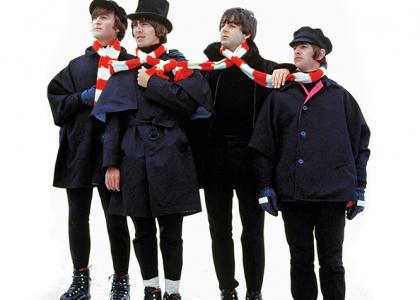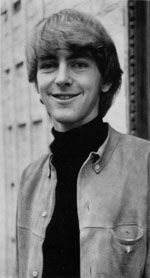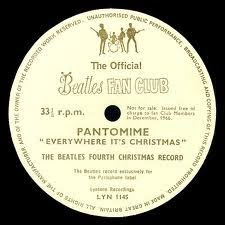MERRY CHRISTMAS FROM JOHN, PAUL, GEORGE AND RINGO!

MERRY CHRISTMAS FROM JOHN, PAUL, GEORGE AND RINGO!

Merry Christmas Eve from the Beatles!

Strawberry Fields Forever was finally completed the day before. Now the Beatles are taking a break until after Christmas.
Studio Two, EMI Studios, Abbey Road
Mixing, editing: Strawberry Fields Forever
After reviewing the tapes of previous sessions, John Lennon decided that he liked both the original recording of Strawberry Fields Forever and the later remake. He asked George Martin to join them together, despite them being in different keys and tempos.
George Martin - That November John came into the studio, and we went into our regular routine. I sat on my high stool with Paul standing beside me, and John stood in front of us with his acoustic guitar and sang the song. It was absolutely lovely. Then we tried it with Ringo on drums, and Paul and George on their bass and electric guitars. It started to get heavy - it wasn't the gently song that I had first heard. We ended up with a record which was very good heavy rock. Still, that was apparently what John wanted, so I metaphorically shrugged my shoulders and said: 'Well, that really wasn't what I'd thought of, but it's OK.' And off John went.
A week later he came back and said: 'I've been thinking about it, too, George. Maybe what we did was wrong. I think we ought to have another go at doing it. Up to that time we had never remade anything. We reckoned that if it didn't work out first time, we shouldn't do it again. But this time we did. 'Maybe we should do it differently,' said John. 'I'd like you to score something for it. Maybe we should have a bit of strings, or brass or something.' Between us we worked out that I should write for cellos and trumpets, together with the group. When I had finished we recorded it again, and I felt that this time it was much better. Off went John again.
A few days later he rang me up and said: 'I like that one, I really do. But, you know, the other one's got something too,'
'Yes, I know,' I said, 'they're both good. But aren't we starting to split hairs?'
Perhaps I shouldn't have used the word 'split', because John's reply was: 'I like the beginning of the first one, and I like the end of the second one. Why don't we just join them together?'
'Well, there are only two things against it,' I said. 'One is that they're in different keys. The other is that they're in different tempos.'
'Yeah, but you can do something about it, I know. You can fix it, George.'
And indeed he could, during this 7-11.30pm session. The first recording had been performed in C major, while the second was in A major. Against the odds, Martin and engineer Geoff Emerick found that by speeding up the first version and slowing down the second, they matched perfectly. The resulting pitch was around B flat.
We gradually decreased the pitch of the first version at the join to make them weld together.First of all new mono mixes were made of both versions. These were numbered RM10 (remix mono 10) from take 7, and RM11 from take 26 (the remake). The mixes were then edited together, and the resulting version was named RM12.
The edit can be found at approximately one minute into the song, following the words "Let me take you down, 'cause I'm". From the first cello note onwards, the sound of the remake is heard.
Sources: Beatles Bible and The Complete Beatles Chronicle
Studio Two, EMI Studios, London
Originally planned for December 15th, (but there was no time to do it that day), "When I'm Sixty-Four" was adorned with the sound of three clarinets between 7:00 and 9:00 pm two ordinary and one a bass clarinet, played by Robert Burns, Henry MacKenzie and Frank Reidy. The recording was then mixed into mono, for acetate-cutting purposes, between 9:00 and 10:00 pm. Between 10:00 and session's end at 11:45 pm John's added yet more vocals and another piano track to take 26 of "Strawberry Fields Forever".
Source: The Complete Beatles Chronicle - Mark Lewisohn
Studio Two, EMI Studios, London
A 7:00 pm-1:00 am session in which Paul, George and John overdubbed backing vocals onto "When I'm Sixty-Four", with Ringo adding the sound of bells. This was followed by another reduction mix, take two becoming takes three and four (the latter marked "best").
Keen to put an end to the nonsense that proliferated in the world's media about the group breaking-up, each of the Beatles consented to give an interview to Independent Television News (ITN) reporter John Edwards for inclusion in the 25-minute weekly series Reporting 66 ("reporting on depth on key stories of the week"). This edition was at first subtitled "Beatles Breaking-Up Special" but then became, more correctly, "End Of Beatlemania", and each member of the group was filmed outside EMI Studios upon arriving for this session, all sporting moustaches and Geore, additionally, a beard. Each one chatted about how the four were remaining together and working on new song material. Reporting '66 was seen all over Britain, although screened by the various ITV regions on different days and times. This edition went out on Wednesday and Thursday, December 28th and 29th (in London, Rediffusion screened it at 6:08-6:35 pm on the Thursday), the remainder of the 25 minute program comprising library footage of the group - and interviews with fans.
Source: The Complete Beatles Chronicle-Mark Lewisohn
On December 17, 1966, Mr. Tara Browne was driving with his girlfriend, model Suki Potier, in his Lots Elan through South Kensington at high speed (some reports suggesting in excess of 106 mph/170 km/h).
He was not under the influence of drugs or alcohol. He failed to see a traffic light and proceeded through the junction of Redcliffe Square and Redcliffe Gardens, colliding with a parked lorry. He died of his injuries the following day. Potier claimed Browne swerved the car to absorb the impact of the crash to save her life.
Browne was survived by his wife Noreen (Nicky) (MacSherry) and their two sons, Dorian and Julian Browne. According to some sources, he was the inspiration for the Beatles song "A Day in the Life".
On January 17, 1967 John Lennon, a friend of Browne's, was composing music at his piano whilst idly reading London's Daily Mail and happened upon the news of the coroner's verdict into Browne's death. He worked the story into the song "A Day in the Life", later released on the album Sgt. Pepper's Lonely Hearts Club Band. The second verse features the following lines:
According to Lennon, in his 1980 interview with Playboy magazine, "I was reading the paper one day and I noticed two stories. One was the Guinness heir who killed himself in a car. That was the main headline story. He died in London in a car crash."
However the song's other lyricist-composer, Paul McCartney, had a very different inspiration. He is quoted as saying: "The verse about the politician blowing his mind out in a car we wrote together. It has been attributed to Tara Browne, the Guinness heir, which I don’t believe is the case, certainly as we were writing it, I was not attributing it to Tara in my head. In John’s head it might have been. In my head I was imagining a politician bombed out on drugs who’d stopped at some traffic lights and didn’t notice that the lights had changed. The ‘blew his mind’ was purely a drugs reference, nothing to do with a car crash."
Lennon remembered McCartney's contributions differently however, saying in Playboy, " Paul's contribution was the beautiful little lick in the song 'I'd love to turn you on.' I had the bulk of the song and the words, but he contributed this little lick floating around in his head that he couldn't use for anything. I thought it was a damn good piece of work."
A less well-known memorial to Browne was composed by Sean O Riada.

The Beatles were in-between sessions today.
The Beatles' Fourth Christmas Record – Pantomime: Everywhere It's Christmas was sent to members of The Beatles' UK fan club on this day.
The audio had been recorded on November 25, 1966, and mixed and edited on December 2, 1966.
Side one: Song: Everywhere It's Christmas; Orowanya; Corsican Choir And Small Choir; A Rare Cheese; Two Elderly Scotsmen; The Feast; The Loyal Toast.
Side two: Podgy The Bear And Jasper; Count Balder And Butler; Felpin Mansions (Part Two); The Count And The Pianist; Song: Please Don't Bring Your Banjo Back; Everywhere It's Christmas; Mal Evans; Reprise: Everywhere It's Christmas.
I drew the cover myself. There's a sort of funny pantomime horse in the design if you look closely. Well I can see one there if you can't. "Paul McCartney"
